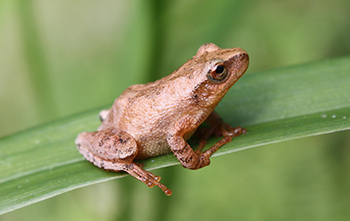Home → Fish & Wildlife → Wildlife → Species Information → Reptiles & Amphibians → Maine Amphibian & Reptile Atlas Project
Maine Amphibian & Reptile Atlas Project

Maine is home to 36 species of herpetofauna, including 18 amphibians (salamanders and frogs) and 18 reptiles (snakes and turtles). Beyond a handful of common, conspicuous species such as the green frog and painted turtle, amphibians and reptiles remain mysterious and misunderstood by many members of the public. This is partly due to their relatively small size – redback salamanders and spring peepers are among the smallest vertebrates in New England – and cryptic habits, often hidden under logs, leaf litter, or below the surface of streams and ponds. To help address this scientific gap in our knowledge of two of the state’s major wildlife groups, MDIFW, in cooperation with Maine Audubon and the University of Maine, launched the Maine Amphibian and Reptile Atlas Project (MARAP) in 1984.
Still active after 36 years, MARAP is one of the longest running citizen science projects in New England, having amassed nearly 13,000 records by hundreds of volunteers statewide. These records will be the foundation of an updated third edition of Amphibians and Reptiles of Maine, currently in preparation.
In addition to improving our knowledge of the biology and distribution of amphibians and reptiles, MARAP has been instrumental for informing conservation status ranks. Reptiles and amphibians are two of the most imperiled taxa worldwide, a pattern of endangerment that is also reflected in the status of Maine's fauna where a relatively large proportion of reptile and amphibian species (24%) are listed as state Endangered or Threatened (three species), Special Concern (four species), or Extirpated (timber rattlesnake). It’s our hope that MARAP will continue to serve not only as a tool for refining our understanding of the biogeography of Maine’s herpetofauna, but also as a means of engagement and inspiration for the next generation of citizen scientists interested in tracking and conserving the state’s biological diversity.
There is much still to learn about the distribution and ecology of Maine’s herpetofauna, and we encourage members of the public to share their photo-documented observations. There are two ways to share your observations:
Submit your reptile or amphibian observation online
No service? No problem. Click here to download the survey to your device while connected, then take offline to collect observations from anywhere. Tip: The survey works best on Google Chrome and Safari.
Or upload sightings to the iNaturalist citizen science project through their website at iNaturalist.org or mobile app.
When submitting an observation through iNaturalist add a description of the location (and other noteworthy information) to the “notes” field. This serves as a check on the locations automatically generated by smartphone cameras, which may be imprecise if cell service or GPS coverage is weak.
Please submit observations of any of the state-listed or special concern reptiles — Blanding's turtle (Endangered), spotted turtle (Threatened), black racer (Endangered), and wood turtle (Special Concern) —to MDIFW immediately by filling out this short online form. For all other species, consult the distribution maps on the individual species pages to see which townships are already documented. If a township lacks a photo or specimen record, we want your observation! For more information, please email kevin.ryan@maine.gov.
This work is supported by volunteer assistance, the federal State Wildlife Grants program, and state revenues from the Loon Conservation Plate and Chickadee Check-off funds.
To view PDF documents, you will need the free Adobe Reader. If you need assistance, view our PDF Help page, or email us.